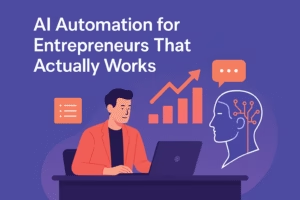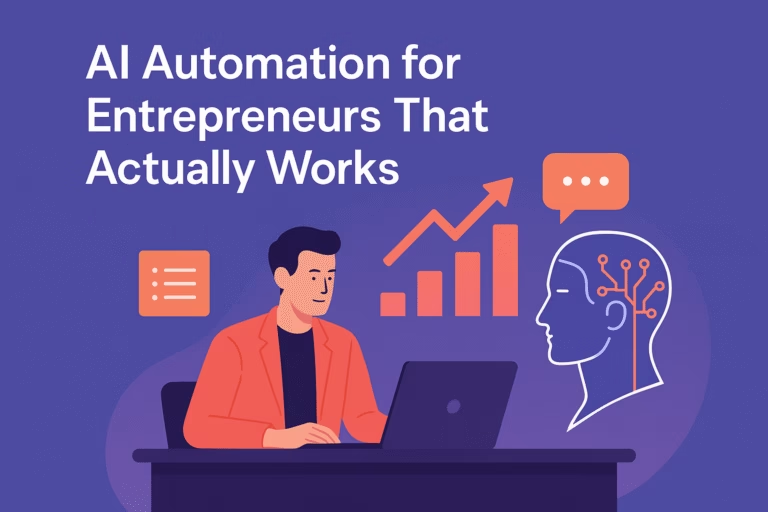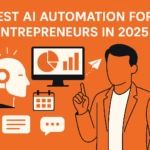Key Takeaways
- AI automation for entrepreneurs only works when built on clear, repeatable systems that run without constant oversight.
- Begin with high-frequency, repetitive tasks; prove the time savings before scaling your setup.
- Keep one central hub connecting content, scheduling, analytics, and reporting for smoother flow.
- Track outcomes that matter — time saved, consistency, and conversion improvements — not just activity.
- Automation should amplify your creativity, not replace it. The human element is the edge.
Every entrepreneur hits that wall — the one made of too many tabs, too many tasks, and not enough sleep. You wake up to pings from clients, pending invoices, and social posts waiting to go live. Somewhere in between, you remember you started this to build freedom, not another job.
That’s where AI automation for entrepreneurs stops being a buzzword and becomes survival. But not all automation works. Most founders pile up tools that barely talk to each other.
They create more work instead of less. Real automation, the kind that actually changes your day, is quiet. It handles the things you repeat, protects your focus, and moves numbers in the background while you work on strategy.
This guide isn’t another “AI will save you” fantasy. It’s about systems that real founders use right now — the ones that pay bills, grow audiences, and reclaim time. Whether you run a one-person business or a lean startup team, what follows will show you how to build an automation setup that doesn’t collapse under its own weight.

What Actually Works in AI Automation
If you search “AI automation for entrepreneurs,” you’ll find endless lists of tools. But tools don’t build freedom — systems do. What works is repeatable, measurable, and low maintenance.
Start with one truth: every task has a pattern. If it happens three times the same way, it can be automated. The trick is to separate useful automation from noisy gimmicks. A working system runs small, quiet tasks that stack value without your constant supervision.
Think of it like compound interest for time. Automate one social post, one follow-up email, one report — suddenly you’ve created a rhythm that runs itself. Over a few months, that rhythm becomes a growth engine.
The entrepreneurs who win with AI aren’t the ones chasing the latest plugin. They’re the ones who build a small set of automations that keep feeding each other. Write once, repurpose everywhere. Capture leads once, nurture forever. Analyze once, act instantly.
It’s not about replacing humans. It’s about building systems so humans can finally think again.
Priority Map for Busy Founders
When everything feels urgent, nothing actually moves. That’s why every serious setup for AI automation for entrepreneurs starts with a clear order of operations. You don’t automate randomly—you build in layers.
Tier One: Daily Revenue Drivers.
These are the high-frequency actions that directly create income or visibility. Scheduling posts, responding to leads, sending offers, publishing updates. These happen every day and eat most of your time. Automate them first. When your outreach and posting run themselves, you finally have space to plan.
Tier Two: Weekly Compounding Tasks.
These are things that make your business stronger but not necessarily richer in the next 24 hours. Content repurposing, analytics review, SEO reporting. They create long-term leverage. Automate them second.
Tier Three: Monthly Hygiene and Insights.
Tax prep, performance summaries, data clean-up. These don’t move money fast but they build control and clarity. Use automation to collect and summarize data rather than act on it.
This tiered map keeps you from building messy stacks of tools that work against each other. Instead, each automation layer feeds the next — like a factory line that turns your daily grind into consistent progress.
Core Use Cases with Outcomes
The best AI automation for entrepreneurs isn’t abstract — it’s daily, visible, and measurable. Below are the top areas where founders save hours and earn more by letting systems take the wheel.
1. Marketing and Content
Use AI to create, repurpose, and schedule content across platforms. One blog post becomes three LinkedIn updates, two tweets, and an email. The goal is volume without burnout. Measure by post frequency and engagement growth.
2. Customer Communication
Automate follow-ups, reminders, and common questions with chatbots or smart emails. When customers feel heard instantly, satisfaction and conversion both rise. Measure by response time and lead close rate.
3. Finance and Reporting
AI now builds dashboards that update automatically, generating summaries and forecasts. Instead of running reports, you get answers. Measure by time saved on accounting tasks and accuracy of predictions.
4. Research and Data Collection
Gather insights from reviews, competitors, and industry news automatically. Let AI summarize and highlight what actually matters. Measure by speed to decision and quality of insights.
5. Project Management
Tasks can self-assign based on triggers or deadlines. The system nudges you before you even think about it. Measure by missed deadlines reduced and project completion rate.
Each of these use cases transforms a recurring headache into a background hum of progress. It’s not the glamour of futuristic AI — it’s the quiet satisfaction of work that finally stays done.
The Four Piece Framework
Every entrepreneur wants to automate but few know how to make it sustainable. So here’s the simple framework that makes AI automation for entrepreneurs actually stick. Four moving parts. Each feeds the next.
1. Capture Tasks.
Start by listing everything you do more than twice a week. Emails, posts, reports, reminders, updates. Don’t filter or judge — capture it all.
2. Generate Drafts.
Use AI to handle first passes. Drafts of newsletters, captions, client reports, even proposals. The goal isn’t perfection, it’s momentum. You review, adjust, and approve — never start from zero again.
3. Distribute Everywhere.
Connect your scheduling, publishing, and analytics tools so one action multiplies into many outputs. The moment you approve content, it can ripple through all platforms in sync.
4. Measure and Improve.
Automation without feedback is just noise. Watch what performs, where engagement happens, and when timing works best. Feed that back into the system.
That loop turns your workflow into a living organism that learns over time. Capture, create, share, refine — then repeat until it feels like your business runs itself while you focus on growth and ideas.
Playbooks by Business Type
Not every founder builds the same kind of company, so their automation shouldn’t look identical. Here’s how AI automation for entrepreneurs adapts to different realities.
Creators
Turn one video or blog post into an entire week of micro-content. AI can transcribe, summarize, caption, and clip. You stay visible even when you’re offline.
Agencies
Automate client brief templates, first draft reports, and progress updates. Instead of juggling admin, you manage creativity. AI gives you a paper trail and performance data to show value.
Ecommerce Owners
Use AI to write product descriptions, run email campaigns, and trigger promotions based on stock levels or abandoned carts. Every click becomes a potential sale without manual chasing.
Consultants and Coaches
Record client calls, let AI summarize them, draft proposals, and schedule follow-ups automatically. You focus on insight, not typing.
These playbooks aren’t theory — they’re what top small businesses are already doing. Each setup cuts routine work, raises consistency, and builds a predictable rhythm. That rhythm, over time, becomes scale.
Tool Selection Checklist
Choosing the right setup is where most entrepreneurs lose momentum. They drown in software lists and demos, never building anything real. The secret to AI automation for entrepreneurs isn’t quantity. It’s fit. You want one tight system that talks to itself, not five apps fighting for attention.
Here’s what separates a working tool from a shiny distraction:
- Seamless integration. It connects smoothly with what you already use — email, calendars, social channels, CRM.
- Smart scheduling. It can plan, post, and reschedule content or reminders automatically.
- Consistent tone. It lets you build a style guide so your brand always sounds like you, not a robot.
- Clear analytics. It tells you what’s working without forcing you to decode graphs.
- Human override. You can review or edit before publishing when something needs judgment.
You don’t need a thousand functions. You need reliability and feedback. When your tools simplify your day instead of complicating it, you’ve got the right mix.
The Hub That Ties It Together
At some point, you stop wanting another app — you want peace of mind. The real win in AI automation for entrepreneurs is when everything lives under one roof. That’s where Blaze Autopilot comes in.
It’s the quiet backbone of modern marketing systems: one dashboard for content writing, scheduling, analytics, and performance tracking. No more jumping between platforms to tweak a post or check data. Everything runs in sequence.
Imagine writing a piece once and watching it distribute across all your channels, gather engagement data, and feed that insight into your next batch automatically. That’s what centralization feels like — not more control panels, but fewer moving parts.
For entrepreneurs, Blaze Autopilot isn’t just another tool. It’s a rhythm keeper. The thing that makes sure your message, your timing, and your output stay in sync even when you step away from the laptop.
Step by Step Setup in One Afternoon
Setting up AI automation for entrepreneurs doesn’t have to take weeks. You can build a functional system in a single afternoon if you follow a deliberate order.
Step 1: List weekly tasks.
Write down everything you do repeatedly — writing, posting, replying, updating. The goal is to see your hidden patterns, not to fix them yet.
Step 2: Mark repetitive actions.
Anything you could teach a beginner in under five minutes is fair game for automation. Email templates, post scheduling, report generation — these are low-risk wins.
Step 3: Choose three to automate now.
Pick the ones that annoy you most. Frustration is a good compass. The first wins build momentum.
Step 4: Connect your calendars and platforms.
Link your social accounts, website, and analytics so data flows automatically. You should never copy-paste anything again.
Step 5: Build a style guide.
Feed your tone, vocabulary, and formatting examples into your AI tools. This keeps your content human while it scales.
Step 6: Run a weekly review.
Once a week, check what worked, tweak prompts, and cut what didn’t. The secret to automation is iteration.
By the end of that afternoon, you’ll have a live system doing small but meaningful work while you rest or sell.
Measurement That Proves It Works
Automation without data is self-deception. The only way to know if your system works is to track how it changes your week. The best AI automation for entrepreneurs setups measure results in human terms — time, clarity, and consistency.
Here’s the core scorecard:
- Time saved per task. If a job took an hour and now takes ten minutes, note the difference.
- Output velocity. How many posts, emails, or updates you ship each week. The goal is growth without fatigue.
- Response speed. Track how quickly leads or clients hear back. Instant response builds trust and loyalty.
- Revenue signals. Look at click-throughs, conversions, and booked calls. These show whether automation is moving real outcomes.
Keep a simple spreadsheet or dashboard that updates automatically. Each week, compare the data to your baseline. If something doesn’t lift numbers or lower stress, it goes.
When your system starts showing time gains and steadier results, that’s when automation stops being an experiment and becomes leverage.
Common Mistakes and Fixes
Even the smartest founders stumble when building AI automation for entrepreneurs because they rush straight into tools without systems. Here’s how that usually plays out — and how to fix it before it drains your energy.
Mistake 1: Automating chaos.
If your workflow is already messy, automation multiplies the mess. You’ll just make bad habits faster.
Fix: Clean the process first. Write the steps manually once, then automate the parts that don’t need judgment.
Mistake 2: Too many disconnected tools.
Each app seems harmless until you’re managing ten dashboards. The overhead kills the time you hoped to save.
Fix: Centralize. Keep a single hub for all automations, preferably one that integrates with your social, CRM, and analytics stack.
Mistake 3: Zero human review.
Blind posting or emailing through AI breaks brand trust faster than bad grammar.
Fix: Always review first drafts before publishing. Think of AI as a fast assistant, not an unsupervised intern.
Mistake 4: Measuring the wrong thing.
Output means nothing if it doesn’t create results. Many people brag about volume instead of outcomes.
Fix: Track time saved, consistency, and conversions — the only metrics that matter for real growth.
The truth is, AI doesn’t ruin businesses. People do, by skipping the boring parts like testing, refining, and measuring. That’s the difference between automation that burns out and automation that compounds.
Advanced Moves When the Basics Run Smoothly
Once your foundation works, AI automation for entrepreneurs becomes an engine that evolves on its own. This is where small refinements start producing big returns.
1. Content refresh loops.
Set your system to identify older posts that performed well but are fading. It can rewrite or repost them automatically with new angles or visuals. You get fresh traffic without fresh effort.
2. Win-back sequences.
Use behavior triggers — if someone hasn’t opened an email in 30 days, your AI can craft a personalized check-in or offer. These small nudges often bring quiet sales back to life.
3. Smart budget shifts.
Feed your ad and content data into the same system so your AI can recommend where to move money each week. It learns where your best returns hide.
4. Auto briefs for next month.
Instead of brainstorming from scratch, your AI can review last month’s performance and build a brief of what to post next. It plans while you sleep.
These aren’t sci-fi dreams. They’re what disciplined entrepreneurs are already doing with lightweight automation stacks. The difference is they start small, fix the leaks, and only then let the system grow teeth.
When it runs right, AI stops being your assistant and becomes your quiet business partner — the one who never takes a day off, never forgets, and never gets tired.
Winding Up
At its best, AI automation for entrepreneurs isn’t about cold efficiency or replacing people. It’s about creating space — the mental quiet where better ideas live. When your tools handle the routine, you stop firefighting and start steering.
Freedom doesn’t come from working less; it comes from working with intent. Automating small daily tasks builds that intent into your schedule. Suddenly you’re writing, thinking, and planning again instead of reacting to the next ping.
The right system runs like background music — always on, rarely noticed, yet shaping the rhythm of your whole business. That’s what automation done right feels like. Quiet momentum.
You don’t need to master every app or chase trends. Start small. Track your wins. Let each automation free a bit of your attention until the business begins running itself, and you get to return to the work only you can do.
FAQs
1. What’s the fastest task to automate?
Scheduling and content posting. Those repetitive actions deliver instant time savings and require no sensitive judgment.
2. How do I keep my brand voice consistent?
Create a tone guide — examples of your writing, words you avoid, and how you speak to customers. Feed this into your AI so it mirrors your personality.
3. How do I know if my automation is worth it?
Track time saved, lead response rate, and output volume over four weeks. If stress goes down and results rise, you’re on the right path.
4. Can a small team or solo founder run automation without tech skills?
Absolutely. Modern platforms are plug-and-play. If you can send an email, you can set up a workflow.
5. What should never be automated?
Empathy, conflict resolution, or creative judgment. Those define your brand and must stay human.




Pingback: AI Automation for Entrepreneurs Made Simple - AI TIPSTERS